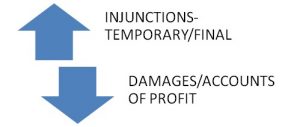By:- Khushi Sharma
Abstract:
Banking can be described as the activities such as depositing and protecting the capital of people and several business organizations and ultimately returning the money as per the wants of the depositors. The term insurance means the process in which the insurer agrees to make good the loss of the insured. There are several types of insurance like life insurance, health insurance etc. For the smooth functioning of banks and financial institutions there are various rules and regulations formed by the legislature. These rules regulate the working of banks and other financial institutions. The banks like any other entity are under the obligation to follow various central and state regulations. The banks majorly deals with the different transactions that takes place on daily basis whereas the financial institutions majorly deals in serving customers to build their businesses. The banking laws are formulated with a view to regulate the lawful fulfillment of the duties allotted to the banks. The insurance laws on the other hand deals with the formation and execution of the Insurance contracts made between the parties.
Learn more about Banking and Insurance Laws with Enhelion’s Online Law firm certified Course!
Introduction:
The banking system plays a very important role in maintaining the economy and financial strength of a country. In the time, where the world is dynamic in nature, the developing countries wants to become developed and already developed ones are eager to rise higher. It is important to note that for the overall growth of any country, a properly functioning banking system is a major requirement. The banking system becomes a pillar in the development of the nation and its economical position. Nonetheless, banks also play a role of financial supporter of the people of the country.
Insurance can be aptly defined as an armor to decrease or completely eliminate the risk attached to one’s life and property. Under the agreement of insurance, the insurer promises the insured to make up for the loss faced by the insured in exchange of an alleged premium fee. The risk against which a person can be insured includes the risk of death,fire,theft,damage etc. Any person can be protected against these risks on the payment of a premium proportionate with the risk involved. Insurance laws are those statutes which deals in policies and claims of insurance.
Learn more about Banking and Insurance Laws with Enhelion’s Online Law firm certified Course!
Banking Laws in India:
In India, the laws for the administration and functioning of banks were formulated in the year 1949, two years after Independence. They enacted on 16th March,1949 and changed the whole banking system. Due to globalization and development of the businesses and trade, the banking institutions in India were becoming the main focus of the time.
In the British era, the most earlier improvement in the system took place with the foundation of Calcutta bank in 1806 followed by the Mumbai bank in 1867. Emperor bank came into existence in 1920, as a result of which the three banks were united with the position of President of Calcutta, Madison and Massa by the laws of the Bank of India.
Learn more about Banking and Insurance Laws with Enhelion’s Online Law firm certified Course!
Insurance Laws in India:
In 1912, the very first statute to regulate the life insurance business came into being and was termed as the Indian Life Assurance Companies Act,1912. Then an act of wider scope formed which enacted for all types of insurance and to formulate strict rules for the insurance business.This was called the Insurance Act of 1938. Due to the Life Insurance Corporation Act,all the 245 insurance agencies working in India were converted into one entity in 1956 and called the Life Insurance Corporation of India. In the year 1972 every insurance company was merged into National Insurance, New India Assurance, Oriental Insurance and United India Insurance which had there headquaters in the metropolitan areas. Till the year 1999, no private insurance agency was left in India. The legislature formulated the Insurance Regulatory and Development Authority Act in 1999 which ultimately permitted the private businesses to carry on the insurance business. Further, the foreign investment was also permitted. The constraint to the FDI in the insurance sector was raised to 49% in the year 2015, subject to some conditions.
Learn more about Banking and Insurance Laws with Enhelion’s Online Law firm certified Course!
Insurance Laws in UAE:
- The nature of UAE in insurance market
In the Gulf Cooperation Council (GCC), the United Arab Emirates insurance market is the largest. In UAE there are three jurisdictions for insurance; namely the Onshore UAE market, the Abu Dhabi Global Market(ADGM) and the Dubai International Financial Centre(DIFC). In recent years, the Islamic insurance market is also growing within the UAE. The alternative system for cooperative islamic insurance is the Takaful Insurance that is also found there.
Learn more about Banking and Insurance Laws with Enhelion’s Online Law firm certified Course!
- The Insurance Regulator
The insurance market of UAE is regulated by the Insurance Authority(IA) which regulates the onshore insurance business. The IA was established in 2007 and the scope of its governance includes insurance and reinsurance companies, entities and intermediaries located in UAE. The UAE cabinet, recently passed an order in October,2020 for the IA to merge with the UAE Central bank. In January 2021, the Central Bank announced that it will take up the regulatory and supervisory responsibility of the insurance sector. Thus we can expect further changes and developments in the insurance sector of UAE in coming years.
Some important provisions of the Insurance law of UAE are worth mentioning-
- Article 7 of the Insurance law talks about the responsibilities of the Insurance Authority.
- Article 8 provides for the constitution of Insurance Authority and that it must include one board, director general and executive body.
- Article 24 states the various forms of companies that are entitled to carry out insurance and reinsurance activities in the UAE.
- Article 26 of the act talks about the limitations of the insurance companies. It protects the UAE properties from being insured outside the country.
Learn more about Banking and Insurance Laws with Enhelion’s Online Law firm certified Course!
Conclusion:
In the era of development and globalization, banking and insurance is the basic need of every country around the world for carrying on its activities globally and develop with the competitor countries. As globalization is increasing with an increase in the technology across the globe, the frauds that are taking place has also raised in number especially those dealing with the banking and insurance industry. All people should deal carefully to avoid risks and get insured for any unforeseen event. Insurance can be aptly defined as an armor to decrease or completely eliminate the risk attached to one’s life and property. Also one must be aware of the laws governing the insurance and its policies before getting one from the provider in order to get the maximum benefit of it. Insurance and banking sectors have come a long way in India and provides ample services at convinient fee which is accessible by the middle class people of the nation. The comparison of Indian and UAE insurance laws shows that both countries have their own way of functioning but the aim is common of both the countries. Insurance sector has come a long way and it still has a long way to go in future.


